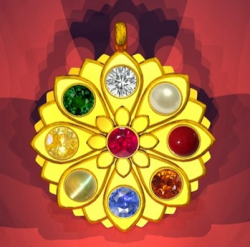Navaratnas

The word “navaratna” (meaning ‘nine gems’ in Sanskrit) refers to an ancient Indian astrological system in which nine specific gems are used to represent the heavenly bodies.
This system, which has also spread to certain countries in Southeast Asia, has its roots in traditional Indian religious practices. While there is no one specific symbol that represents the concept of navaratnas, the gems themselves are often set into jewelry and other forms of personal adornment, and there is a strict formula that dictates the placement of each one:
The RUBY (which represents the sun) is always in the center, surrounded in clockwise order by the DIAMOND (representing Venus), PEARL (moon), RED CORAL (Mars), HESSONITE (ascending moon), BLUE SAPPHIRE (Saturn), CAT’S EYE (descending moon), YELLOW SAPPHIRE (Jupiter) and EMERALD (Mercury).
The significance of the navaratnas is recognized in all four of India’s native religions (Hinduism, Buddhism, Jainism and Sikhism), and in Thailand there exists The Ancient and Auspicious Order of the Nine Gems. Established in the 19th century for the royal family and important officials of the kingdom, to be inducted is a highly distinguished honor.
© Symbols.com
